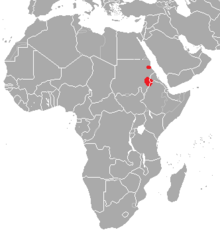
The term antelope is used to refer to many species of even-toed ruminant that are indigenous to various regions in Africa and Eurasia.

The hartebeest, also known as kongoni or kaama, is an African antelope. It is the only member of the genus Alcelaphus. Eight subspecies have been described, including two sometimes considered to be independent species. A large antelope, the hartebeest stands just over 1 m at the shoulder, and has a typical head-and-body length of 200 to 250 cm. The weight ranges from 100 to 200 kg. It has a particularly elongated forehead and oddly-shaped horns, a short neck, and pointed ears. Its legs, which often have black markings, are unusually long. The coat is generally short and shiny. Coat colour varies by the subspecies, from the sandy brown of the western hartebeest to the chocolate brown of the Swayne's hartebeest. Both sexes of all subspecies have horns, with those of females being more slender. Horns can reach lengths of 45–70 cm (18–28 in). Apart from its long face, the large chest and the sharply sloping back differentiate the hartebeest from other antelopes. A conspicuous hump over the shoulders is due to the long dorsal processes of the vertebrae in this region.
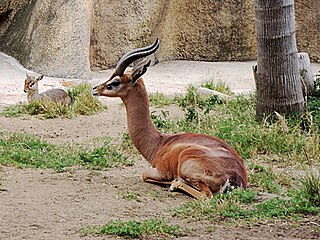
The gerenuk, also known as the giraffe gazelle, is a long-necked antelope found in parts of East Africa. The sole member of the genus Litocranius, the gerenuk was first described by the naturalist Victor Brooke in 1879. It is characterised by its long, slender neck and limbs. The antelope is 80–105 centimetres tall, and weighs between 18 and 52 kilograms. Two types of colouration are clearly visible on the smooth coat: the reddish brown back or the "saddle", and the lighter flanks, fawn to buff. The horns, present only on males, are lyre-shaped. Curving backward then slightly forward, these measure 25–44 cm.

The red gazelle is an extinct species or subspecies of gazelle. It was formerly considered a member of the genus Gazella within the subgenus Eudorcas before Eudorcas was promoted to a full genus. It is thought to have lived in the better-watered mountain areas of North Africa rather than in deserts, because of the rich colouring on the coat.

The dorcas gazelle, also known as the ariel gazelle, is a small and common gazelle. The dorcas gazelle stands about 55–65 cm at the shoulder, with a head and body length of 90–110 cm and a weight of 15–20 kg. The numerous subspecies survive on vegetation in grassland, steppe, wadis, mountain desert and in semidesert climates of Africa and Arabia. About 35,000–40,000 exist in the wild.

The Antilopines are even-toed ungulates belonging to the subfamily Antilopinae of the family Bovidae. The members of tribe Antilopini include the gazelles, blackbucks, springboks, gerenuks, dibatags, and Central Asian gazelles, are often referred to as true antelopes. True antelopes occur in much of Africa and Asia, with the highest concentration of species occurring in East Africa in Sudan, Eritrea, Ethiopia, Somalia, Kenya, and Tanzania. The saigas and Tibetan antelopes inhabit much of central and western Asia. The dwarf antelopes of tribe Neotragini live entirely in sub-Saharan Africa.

The mountain gazelle, also called the Palestine mountain gazelle, is a species of gazelle widely but unevenly distributed.

The rhim gazelle or rhim, also known as the slender-horned gazelle, African sand gazelle or Loder's gazelle, is a pale-coated gazelle with long slender horns and well adapted to desert life. It is considered an endangered species because fewer than 2500 are left in the wild. They are found in Algeria, Egypt, Tunisia and Libya, and possibly Chad, Mali, Niger, and Sudan.

Thomson's gazelle is one of the best known species of gazelles. It is named after explorer Joseph Thomson and is sometimes referred to as a "tommie". It is considered by some to be a subspecies of the red-fronted gazelle and was formerly considered a member of the genus Gazella within the subgenus Eudorcas, before Eudorcas was elevated to genus status.
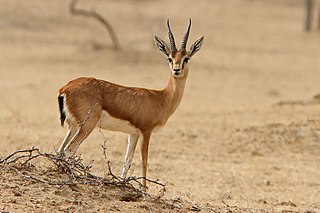
The chinkara, also known as the Indian gazelle, is a gazelle species native to Iran, Afghanistan, Pakistan and India.

The dibatag, or Clarke's gazelle, is a medium-sized slender antelope native to Ethiopia and Somalia. Though not a true gazelle, it is similarly marked, with long legs and neck. It is often confused with the gerenuk due to their striking resemblance. The typical head-and-body length is about 103 to 117 cm. They stand up to about 80 to 90 cm. Male dibatag weigh between 20 and 35 kg, whereas females range from 22 and 29 kg. The length of the curved horns, present only on males, is typically between 10 and 25 cm. The upper parts are gray to fawn, while the dorsal and lateral areas are cinnamon to rufous. The underparts, rump and the insides of the legs are all white. While markings are visible on the face, there are none on the flanks or the buttocks.

Soemmerring's gazelle, also known as the Abyssinian mohr, is a gazelle species native to the Horn of Africa. The species was described and given its binomen by German physician Philipp Jakob Cretzschmar in 1828. Three subspecies are recognized. It is possibly no longer present in Sudan.

The red-fronted gazelle is widely but unevenly distributed gazelle across the middle of Africa from Senegal to northeastern Ethiopia. It is mainly resident in the Sahel zone, a narrow cross-Africa band south of the Sahara, where it prefers arid grasslands, wooded savannas and shrubby steppes.

Grant's gazelle is a species of gazelle distributed from northern Tanzania to South Sudan and Ethiopia, and from the Kenyan coast to Lake Victoria. Its Swahili name is swala granti. It was named for a 19th-century British explorer, James Grant.
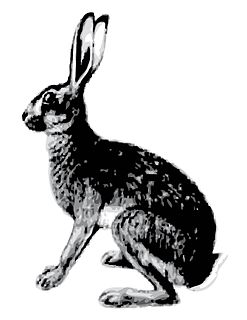
The Abyssinian hare is a species of mammal in the family Leporidae. It is almost entirely restricted to the nations of the Horn of Africa, though it extends marginally into eastern Sudan and may also occur in far northern Kenya.
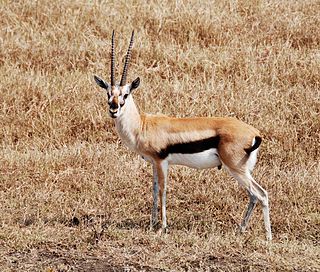
Eudorcas is a genus of antelope; the species are commonly called gazelles. Eudorcas was originally considered a subgenus of the genus Gazella but has since been elevated to generic status. The five species within the genus Eudorcas are:

A gazelle is one of many antelope species in the genus Gazella. This article also deals with the seven species included in two further genera, Eudorcas and Nanger, which were formerly considered subgenera of Gazella. A third former subgenus, Procapra, includes three living species of Asian gazelles.

The Mongalla gazelle is a species of gazelle found in the floodplain and savanna of South Sudan. It was first described by British zoologist Walter Rothschild in 1903. The taxonomic status of the Mongalla gazelle is widely disputed. While some authorities consider it a full-fledged monotypic species in the genus Eudorcas, it is often considered a subspecies of Thomson's gazelle, while other authorities regard it as subspecies of the red-fronted gazelle.

